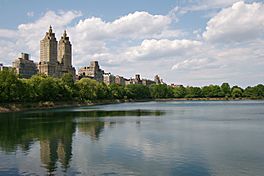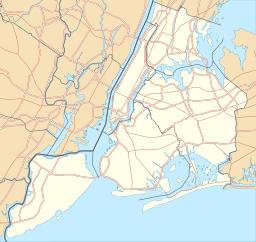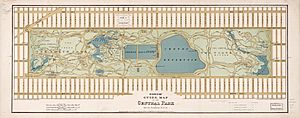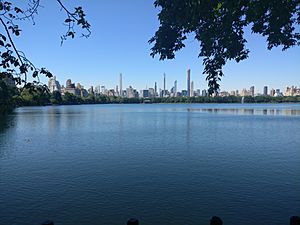Jacqueline Kennedy Onassis Reservoir facts for kids
Quick facts for kids Jacqueline Kennedy Onassis Reservoir |
|
|---|---|
 |
|
| Location | Central Park, New York City |
| Coordinates | 40°47′6.32″N 73°57′37.71″W / 40.7850889°N 73.9604750°W |
| Type | Reservoir |
| Basin countries | United States |
| Surface area | 106 acres (43 ha) |
| Average depth | 8.8 m (29 ft) |
| Water volume | 3.8 million cubic metres (3,100 acre⋅ft) |
| Shore length1 | 1.58 mi (2.5 km) |
| 1 Shore length is not a well-defined measure. | |
The Jacqueline Kennedy Onassis Reservoir, also known as the Central Park Reservoir, is a large, former reservoir located in Central Park in Manhattan, New York City. It stretches from 86th to 96th Streets. This huge body of water covers 106 acres (43 ha) (about 43 hectares) and once held over 1,000,000,000 US gallons (3,800,000 m3) of water.
In the 1850s, the idea for Central Park grew around an existing reservoir. The Central Park Reservoir itself was finished in 1862. It was used to help supply water to New York City for many years.
However, the reservoir was no longer needed for water supply by 1993. It was then given to the New York City Department of Parks and Recreation in 1999. In 1994, the reservoir was renamed to honor Jacqueline Kennedy Onassis. This was to remember her important work for the city, and because she lived nearby.
Contents
History of the Reservoir
Planning and Building
In the 1850s, Nicholas Dean, who led the Croton Aqueduct Board, suggested building Central Park. He chose the spot because a smaller water reservoir, built in 1842, was already there. This older reservoir was called the Yorkville Reservoir or the Lower Reservoir. Today, the Great Lawn and Turtle Pond are located where it used to be.
In 1857, a contest was held to design Central Park. The plans had to include a larger "Upper Reservoir" for the Croton Aqueduct water system. The winning design was called the Greensward Plan, created by Frederick Law Olmsted and Calvert Vaux. Vaux designed the reservoir's two pump houses using local stone. This reservoir was not meant to collect water, but to add to the city's water supply.
It took some time to get money for Central Park. Finally, in June 1858, workers and funds were secured. Work on the Upper Reservoir began in April 1858. The southern part of Central Park was mostly done by 1860. The Croton Aqueduct board also started filling the reservoir around this time. The Upper Reservoir was fully finished by 1862. An old map from 1875 clearly shows both the Lower and Upper reservoirs.
No Longer Used for Water
The reservoir stopped being used for the city's main water supply in 1993. This happened because a new water main was built, and people worried the reservoir's water could get dirty. Even though it was no longer the main water source, it was kept in case of droughts.
In 1992, people worried that the city might cover the reservoir with grass, like they did with the smaller Lower Reservoir in the 1920s. That area became the Great Lawn. Many people wrote letters to ask the city to keep the reservoir as it was.
In 1999, control of the reservoir was officially moved from the New York City Department of Environmental Protection to the New York City Department of Parks and Recreation. This change happened after a new water filtration plant was expected to be finished. The water filtration plant started working in 2015.
Renamed for Jacqueline Kennedy Onassis
In 1994, the reservoir was renamed the Jacqueline Kennedy Onassis Reservoir. This was done to honor her important work for New York City. She helped save Grand Central Terminal from being torn down and worked to protect Central Park's beauty. She also enjoyed jogging around the reservoir. Her apartment on Fifth Avenue overlooked this area.
About the Reservoir Today
The reservoir is 106 acres (43 ha) (43 hectares) in size and holds a lot of water. Even though it no longer supplies drinking water to the city, it still provides water for the Pool and the Harlem Meer within Central Park.
It is a very popular spot in Central Park. There is a 1.58-mile (2.54 km) (2.54 km) jogging track around it. Many runners, including famous people like Bill Clinton, Barack Obama, and Madonna, have used this track.
The reservoir is also a beautiful place to visit, especially when the pink "Yoshino" and "Kanzan" cherry trees are blooming. The rhododendron flowers along the "Rhododendron Mile" were a gift to the city in 1909.
The reservoir area is an important place for nature in the park. More than 20 types of waterbirds visit, including coots, mergansers, northern shovelers, ruddy ducks, buffleheads, loons, cormorants, wood ducks, American black ducks, gadwall, grebes, herons, and egrets. You can also see common mallards and Canada geese. This makes it a great place for birdwatching.
Images for kids
See also
 In Spanish: Embalse Jacqueline Kennedy Onassis para niños
In Spanish: Embalse Jacqueline Kennedy Onassis para niños






